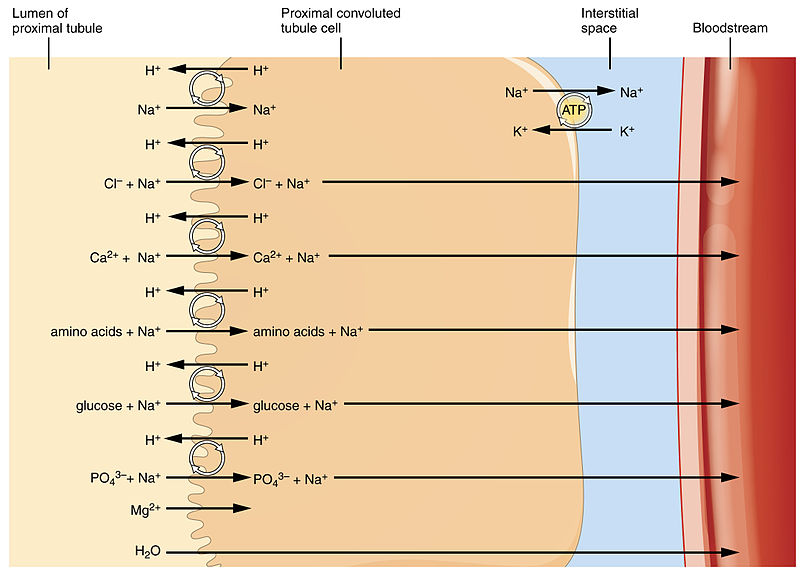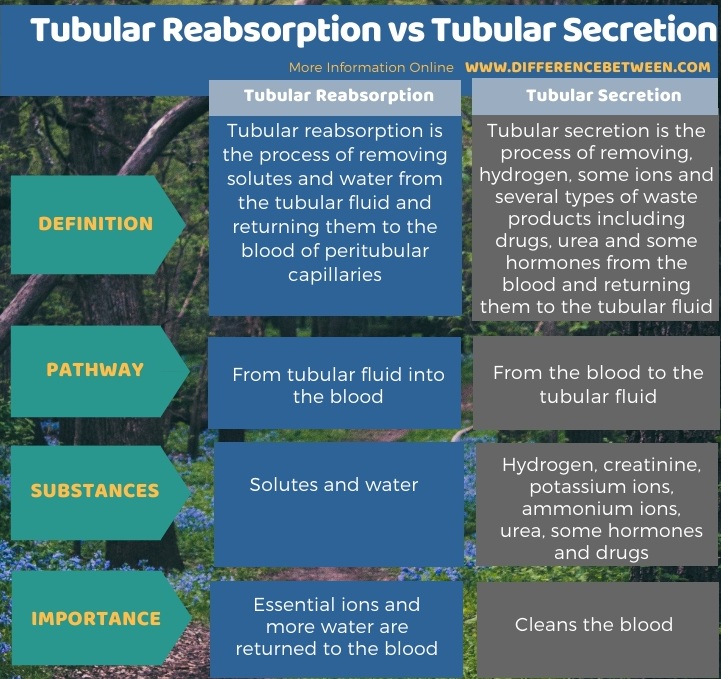Difference Between Tubular Reabsorption and Tubular Secretion
Table of Contents
The key difference between tubular reabsorption and tubular secretion is that tubular reabsorption involves the removal of some solutes and water from the tubular fluid and their return to the blood, while tubular secretion involves the removal of hydrogen, creatinine, and drugs from the blood and return to the collecting duct.
Urine is a by-product derived from excess water and metabolic waste molecules. Filtration, secretion and reabsorption are the three major steps of urine formation in kidneys. Blood filtration takes place in the glomerulus. Water and nitrogenous waste filter into glomerulus from the blood. Then the glomerular filtrate travels through the other parts of the nephron, including proximal/distal convoluted tubules, the loop of Henle, and collecting duct. Re-absorption of essential molecules and ions takes place when the glomerular filtrate passes through the nephron. Moreover, some substances, such as hydrogen ions, creatinine, and drugs, etc., will be secreted into the collecting duct from the blood.
CONTENTS
1. Overview and Key Difference
2. What is Tubular Reabsorption
3. What is Tubular Secretion
4. Similarities Between Tubular Reabsorption and Tubular Secretion
5. Side by Side Comparison – Tubular Reabsorption vs Tubular Secretion in Tabular Form
6. Summary
What is Tubular Reabsorption?
Tubular reabsorption is one of the three main steps of urine formation. It is the process of moving solutes and water from the tubular fluid into the circulating blood. In fact, these solutes and water are reabsorbed into the peritubular capillaries, which are tiny blood vessels running around the nephron. As a result of the tubular reabsorption, the tubular fluid becomes more concentrated. Therefore, the reabsorbed solutes, ions and water are returned back to the blood in the peri-tubular capillaries.

Figure 01: Tubular Reabsorption and Tubular Secretion
Reabsorption can occur through passive or active processes. Passive diffusion takes place via the plasma membrane of the kidney epithelial cells, based on the concentration gradient. Active transport takes place via the membrane-bound ATPases. In addition, cotransport also takes place in order to reabsorb water.
What is Tubular Secretion?
Tubular secretion is another major step of urine formation. It is the process of removing hydrogen, creatinine, ions (potassium ions, ammonium ions, etc.) and other types of waste products including drugs, urea, and some hormones from the blood in the peri-tubular capillaries and returning them to the tubular fluid in the renal tubular lumen. It is important in order to maintain blood pH in the normal level. Moreover, it helps to clean the blood.

Figure 02: Substances Reabsorbed and Secreted
Similar to reabsorption, tubular secretion also takes place via passive diffusion and active transport. Once the secretion process is complete, urine excretes from the body via the urethra.
What are the Similarities Between Tubular Reabsorption and Tubular Secretion?
- Tubular reabsorption and tubular secretion are two opposite processes.
- Both processes take place between tubular fluid and blood in the peri-tubular capillary network.
- Urine is the final product leftover in the collecting duct after reabsorption and secretion.
What is the Difference Between Tubular Reabsorption and Tubular Secretion?
Tubular reabsorption and tubular secretion are two major steps occurring in nephrons. Tubular reabsorption is the process of removing solutes and water from the tubular fluid and returning them into the blood of peritubular capillaries. Meanwhile, tubular secretion is the process of removing hydrogen, some ions and waste products like drugs, urea and some hormones from the blood and returning them to the tubular fluid. So, this is the key difference between tubular reabsorption and tubular secretion. Besides, some solutes and most of the water are reabsorbed from the tubular fluid into the blood while some ions, waste products, drugs, and some hormones are secreted from the blood to the tubular fluid.
Moreover, tubular reabsorption is important since it saves some essential solutes and water while tubular secretion is important since it maintains blood pH and cleans the blood. Therefore, this is another difference between tubular reabsorption and tubular secretion.

Summary – Tubular Reabsorption vs Tubular Secretion
Tubular reabsorption and tubular secretion are two of the three major steps of urine formation. Tubular reabsorption refers to the process of moving solutes and water from the tubular fluid into the circulating blood through the peritubular capillary network. Tubular secretion is the opposite process by which some ions, hydrogen, drugs and other waste products are removed from the blood through the per-tubular capillary network and returned to the tubular fluid of the collecting duct. So, this is the key difference between tubular reabsorption and tubular secretion.
Reference:
1. “Physiology of the Kidneys.” Lumen, Available here.
2. “The Three Processes of Urine Formation.” Study.com, Available here.
Image Courtesy:
1. “2618 Nephron Secretion Reabsorption” By OpenStax College – Anatomy & Physiology, Connexions Web site. Available here, Jun 19, 2013 (CC BY 3.0) via Commons Wikimedia
2. “2619 Substances Reabsorbed And Secreted By The PCT” By OpenStax College – Anatomy & Physiology, Connexions Web site, Jun 19, 2013 (CC BY 3.0) via Commons Wikimedia
ncG1vNJzZmivp6x7pbXFn5yrnZ6YsqOx07CcnqZemLyue8OinZ%2Bdopq7pLGMm5ytr5Wau27A1JuspZmiYr%2BmrcGspquopJ68r3nAp5tmrKWXwq2t0WaqnpuimsGqu81o